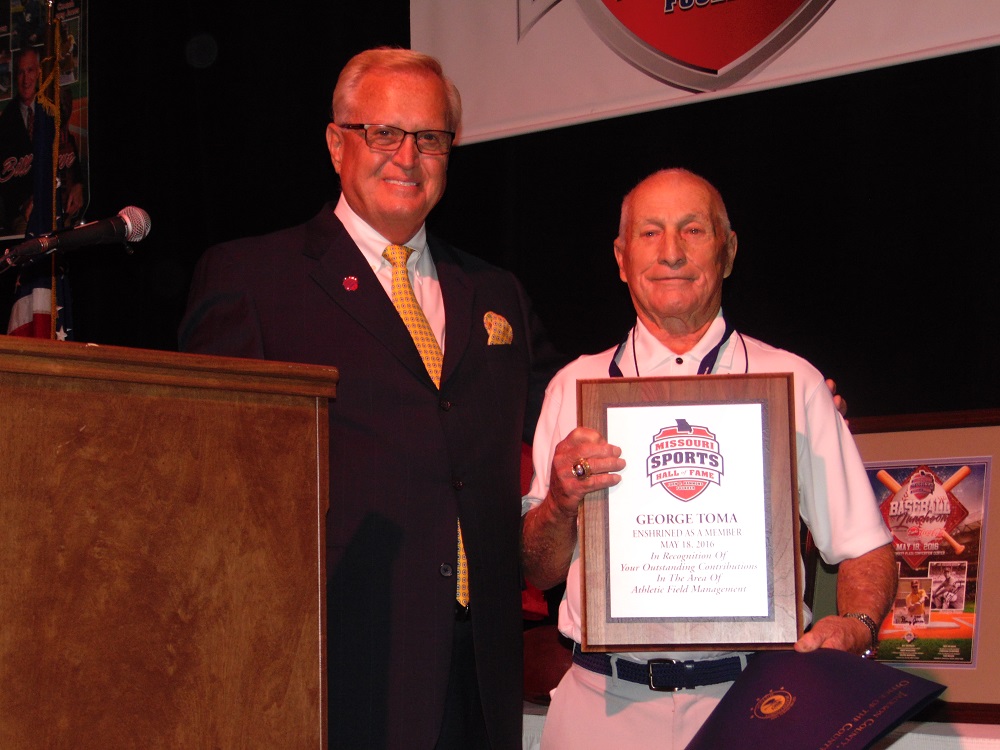Inductees
George Toma

Born: February 2, 1929
At age 10, he went to work on a vegetable farm, but not by choice. The family needed the money after his dad, a coal miner in eastern Pennsylvania, passed away.
Fortunately for George Toma, the minor leagues rescued him as a teenager in the 1940s. But not because he could hit or pitch. Instead, clubs sought a reliable groundskeeper – and, over the next seven decades, Toma became one of the most respected in America.
In fact, he launched into stardom from Kansas City. This despite friends warning Toma to avoid taking a job in overseeing the city’s Municipal Stadium, then home of the big-league Athletics. The field was cooked, and the weather would cook him, he was told.
“So I went out there on Labor Day 1957 to look it over,” Toma said. And … “If I mess it up,” Toma thought to himself, “nobody will ever know it.”
Toma turned the canvas, er, field into his own Sistine Chapel and created quite a legacy, one that is leading to induction into the Missouri Sports Hall of Fame with the Class of 2016.
Toma has been as synonymous with Kansas City as barbecue. He worked for the Athletics until they moved to California in 1967, and then the Kansas City Royals (1969-1999) and the Kansas Chiefs (1963-1991) as they moved from Municipal Stadium into the Truman Sports Complex.
Along the way, Toma has handled field prep work of all 50 Super Bowls. He also oversaw the infields of the Los Angeles Coliseum and Atlanta’s Olympic Stadium for the 1984 and 1996 Summer Olympics, respectively, and several fields of the 1994 World Cup Soccer. For the 1996 Atlanta Games, alone, Toma led the installation of 13,500 yards of sod in 24 hours with 12 hours of sod bed preparation.
Additionally, Toma has prepared fields for 37 Pro Bowls, and in 2005 readied Louisiana State’s Tiger Stadium after Hurricane Katrina led the New Orleans Saints to relocate games there. He also worked Kauffman Stadium during the 2014 and 2015 World Series.
“The cheapest insurance for an athlete is a good, safe playing field,” Toma said. “And I liked to do it without taking too much money out of the owners’ coffers.”
Toma’s big break came in 1942 with the Wilkes-Barre (Pa.) Barons. He then spent the next 15 years working as a groundskeeper of minor league ballparks. At one stop in Virginia, he mentored under Emil Bossard, one of baseball’s earliest and respected groundskeepers.
All of which set up Toma for success in Kansas City, where his first masterpiece was the turnaround of Municipal Stadium in 1958. The field was home to big-league baseball with the Athletics, after serving for decades as a baseball home to Triple-A clubs and the Negro Leagues’ Kansas City Monarchs.
“It had a lot of weeds, so I killed most of the field. In about a month, the field was one of the best in the majors – a pool table,” Toma said. “We didn’t sod. We used pre-germinated grass seed, and never re-sodded for sports changes, A’s baseball, Royals, Chiefs, Spurs soccer and special events. Now teams re-sod their fields two or three times a year.”
After the Chiefs relocated from Dallas in 1963, Municipal Stadium became all the more challenging. Remarkably, it maintained its pristine condition. In fact, then-National Football League commissioner Pete Rozelle visited for a Chiefs game and Toma recalled that “He said he had never seen such a beautiful, outstanding playing field for football. That made the press the next day.” It was the comment that led to Toma overseeing field work of the first Super Bowl, and all others thereafter.
Toma for years never had a full-time assistant.
“If it weren’t for the boys from Lincoln High School and Central High School, there would be no George Toma,” he said, explaining teenagers from those nearby schools would drop by and help ready Municipal Stadium’s field. “We had the best baseball field in sports.”
Along the way, Toma worked out deals with Anderson Fertilizer, International Seeds and several others. John Deere donated $700,000 worth of equipment to his efforts. He also oversaw the grounds of the personal estate for then-Royals owner Ewing Kauffman, and William Jewell College’s athletics fields.
“As I look back now, I was a pioneer,” Toma said. “I love Kansas City. I didn’t want to leave Kansas City. I could’ve worked for other ball clubs. But this town has taken care of me.”
Just as he has taken care of its prized fields.